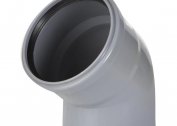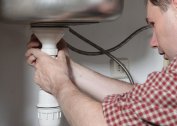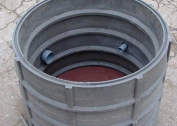When the sewer system of a house is correctly designed and installed, residents have no questions about “how it works”. How to achieve this effect and ensure reliable, stable drainage?
What is the angle of inclination and why is it needed
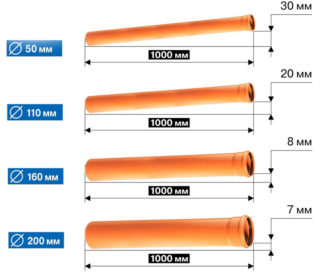 Sewerage in private homes is arranged on the principle of gravity. This means that the wastewater moves through pipes obeying the force of gravity. In order for the system to uninterruptedly, reliably perform its functions, it must be able to self-clean. At the same time, the effluent is fully transferred to a septic tank or storage tank, and solid large deposits do not settle in sewer pipes.
Sewerage in private homes is arranged on the principle of gravity. This means that the wastewater moves through pipes obeying the force of gravity. In order for the system to uninterruptedly, reliably perform its functions, it must be able to self-clean. At the same time, the effluent is fully transferred to a septic tank or storage tank, and solid large deposits do not settle in sewer pipes.
The desired effect can be achieved by providing the required angle of inclination of the pipe. This is the difference in height at the inlet and outlet of the sewer system.
The slope of the pipeline gives the flow the right intensity. The rate of movement of wastewater should be such that the liquid carries away sewage and more dense flow elements. In this case, the angle varies depending on the diameter of the pipe. There are standards, compliance with which guarantees the effective operation of the sewage system.
Tilt Standards
 Building codes and regulations (SNiP) prescribe the optimal angle of inclination of the drainage system. Compliance with these standards ensures the effective operation of the pipeline and simplifies its maintenance.
Building codes and regulations (SNiP) prescribe the optimal angle of inclination of the drainage system. Compliance with these standards ensures the effective operation of the pipeline and simplifies its maintenance.
The smaller the diameter of the pipe, the greater the angle of inclination. So for a pipe with a diameter of 50 mm, the minimum slope should be 30 mm per meter of length. And for a diameter of 200 mm - it will be 7 mm. The normal angle of inclination may be 40% greater, but a significant excess is fraught with a violation of the effectiveness of the system. With increasing angle, the speed of movement of wastewater increases. In this case, the liquid moves much faster than solid waste, a “separation effect” occurs, which means that the principle of pipe self-cleaning is violated. As a result, clogging of the channel occurs.
Normal is considered to be a flow velocity of 1.43 m / s. Compliance with the slope standards provides such a speed, and this is the key to the efficiency of the sewer network.
Method of selection and calculation of the optimal value
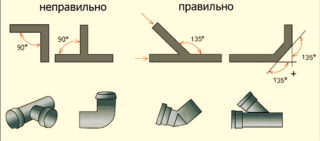 For the design of sewage communications, a settlement or non-accounting method of forming a system is practiced. The design option requires information about the constant pressure of the fluid being transported, which is appropriate in the main pipelines.
For the design of sewage communications, a settlement or non-accounting method of forming a system is practiced. The design option requires information about the constant pressure of the fluid being transported, which is appropriate in the main pipelines.
For a private house, an uncalculated design method is used. Here the diameter of the pipe is taken into account and the corresponding angle of inclination is fixed.
Each plumbing fixture is connected to the system with a pipe of the recommended section. For a private house, this is a range of diameters from 32 to 110 mm. It is important that the cross section of the drainage pipe is not less than the cross section of the outlet of the household appliance. For a toilet it is 110 mm, for a kitchen sink, bath or shower - 50 mm, and for a washing machine even 32 mm will be enough.
Accordingly, for the 110th pipeline, the optimal design slope will be 0.02 m per linear meter. A pipe with a cross section of 50 mm should be tilted by 0.03 m (for each meter of length).
Calculation for apartments and houses separately
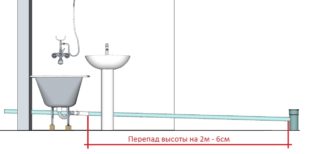 In apartments, all plumbing fixtures are compactly located next to the main riser of the apartment building. This is due to the inability to provide sufficient bias and to guarantee the correct operation of communications if the source is far removed.
In apartments, all plumbing fixtures are compactly located next to the main riser of the apartment building. This is due to the inability to provide sufficient bias and to guarantee the correct operation of communications if the source is far removed.
Such placement greatly simplifies the design of a sewage system. It is enough to ensure a minimum angle of inclination of the pipes. With the length of the local system (located within the apartment) not exceeding 5 m, the height difference is a maximum of 15 cm.
For a private house, design calculation is more complicated. It is important to consider the features of the installation of internal and external piping.
There are separate standards for the external part of the system connecting the septic tank or storage tank with the internal sewage of the building. The pipe should be laid at a depth exceeding the freezing zone. For temperate latitudes - this is 1m. This depth eliminates freezing of the system. If it is not possible to deeply lay communications, it is necessary to ensure the heating of the pipeline. For this, a heating cable is laid in parallel with the sewage system, ensuring normal temperature conditions.
The internal sector of the sewer complex includes the following elements:
- plumbing fixtures equipped with pressurized hydraulic locks;
- exhaust pipes laid with a slope;
- vertical riser accepting all bypass channels;
- revisions providing emergency cleaning of the channel;
- fan vent pipe providing gas exhaust.
A rational combination of elements allows you to create an effective drainage system operating in gravity mode.
Common mistakes and methods for solving them
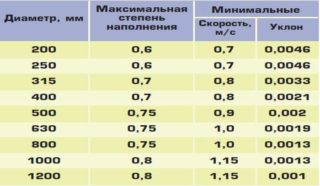 The most common violation of Construction Norms and Regulations during the installation of wastewater is considered to be non-compliance with the angle of the pipes. At the same time, both a decrease in the angle below the permissible limits and an excessive increase in this indicator lead to problems.
The most common violation of Construction Norms and Regulations during the installation of wastewater is considered to be non-compliance with the angle of the pipes. At the same time, both a decrease in the angle below the permissible limits and an excessive increase in this indicator lead to problems.
Another typical mistake for private homes is the lack of ventilating fan release. With this design, there is not enough ventilation of the pipeline, the regular operation of siphons, stop valves is disrupted.
To eliminate the problem, it is necessary to organize the release through the roof, placing the upper edge of the pipe 500 mm above the roofing plane.
The next typical problem is the incorrect organization of the septic tank treatment system. Calculation of a multi-chamber system that provides sufficient performance, post-treatment and disposal of treated water, will save during operation.
It is important to take into account seasonal fluctuations in the groundwater level when organizing a storage tank. Neglecting soil surveys can lead to sewage problems.
A thorough, thoughtful calculation of sewer communications ensures the correct operation of the system, ensures the comfort of use. For autonomous sewage of a private house, this is especially important.
